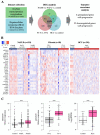Plasma Aldo-Keto Reductase Family 1 Member B10 as a Biomarker Performs Well in the Diagnosis of Nonalcoholic Steatohepatitis and Fibrosis
- PMID: 35563425
- PMCID: PMC9101253
- DOI: 10.3390/ijms23095035
Plasma Aldo-Keto Reductase Family 1 Member B10 as a Biomarker Performs Well in the Diagnosis of Nonalcoholic Steatohepatitis and Fibrosis
Abstract
We found several blood biomarkers through computational secretome analyses, including aldo-keto reductase family 1 member B10 (AKR1B10), which reflected the progression of nonalcoholic fatty liver disease (NAFLD). After confirming that hepatic AKR1B10 reflected the progression of NAFLD in a subgroup with NAFLD, we evaluated the diagnostic accuracy of plasma AKR1B10 and other biomarkers for the diagnosis of nonalcoholic steatohepatitis (NASH) and fibrosis in replication cohort. We enrolled healthy control subjects and patients with biopsy-proven NAFLD (n = 102) and evaluated the performance of various diagnostic markers. Plasma AKR1B10 performed well in the diagnosis of NASH with an area under the receiver operating characteristic (AUROC) curve of 0.834 and a cutoff value of 1078.2 pg/mL, as well as advanced fibrosis (AUROC curve value of 0.914 and cutoff level 1078.2 pg/mL), with further improvement in combination with C3. When we monitored a subgroup of obese patients who underwent bariatric surgery (n = 35), plasma AKR1B10 decreased dramatically, and 40.0% of patients with NASH at baseline showed a decrease in plasma AKR1B10 levels to below the cutoff level after the surgery. In an independent validation study, we proved that plasma AKR1B10 was a specific biomarker of NAFLD progression across varying degrees of renal dysfunction. Despite perfect correlation between plasma and serum levels of AKR1B10 in paired sample analysis, its serum level was 1.4-fold higher than that in plasma. Plasma AKR1B10 alone and in combination with C3 could be a useful noninvasive biomarker for the diagnosis of NASH and hepatic fibrosis.
Keywords: aldo-keto reductase family 1 member B10; biomarkers; diagnosis; nonalcoholic fatty liver disease.
Conflict of interest statement
The authors declare no conflict of interest.
Figures





References
-
- Lassailly G., Caiazzo R., Ntandja-Wandji L.-C., Gnemmi V., Baud G., Verkindt H., Ningarhari M., Louvet A., Leteurtre E., Raverdy V., et al. Bariatric Surgery Provides Long-term Resolution of Nonalcoholic Steatohepatitis and Regression of Fibrosis. Gastroenterology. 2020;159:1290–1301.e5. doi: 10.1053/j.gastro.2020.06.006. - DOI - PubMed
-
- Stratopoulos C., Papakonstantinou A., Terzis I., Spiliadi C., Dimitriades G., Komesidou V., Kitsanta P., Argyrakos T., Hadjiyannakis E. Changes in Liver Histology Accompanying Massive Weight Loss after Gastroplasty for Morbid Obesity. Obes. Surg. 2005;15:1154–1160. doi: 10.1381/0960892055002239. - DOI - PubMed
-
- Salman M.A., Mikhail H.M.S., Nafea M.A., Sultan A.A.E.A., Elshafey H.E., Tourky M., Awad A., Abouelregal T.E., Ahmed R.A., Ashoush O., et al. Impact of laparoscopic sleeve gastrectomy on fibrosis stage in patients with child-A NASH-related cirrhosis. Surg. Endosc. 2021;35:1269–1277. doi: 10.1007/s00464-020-07498-4. - DOI - PubMed
MeSH terms
Substances
Grants and funding
LinkOut - more resources
Full Text Sources
Other Literature Sources
Medical
Miscellaneous

